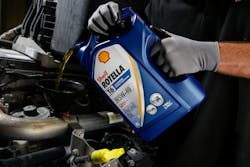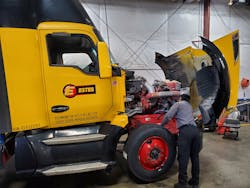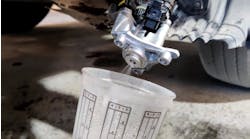Rising oil prices are making headlines again. Impacted by a global pandemic, economic issues, and geopolitical factors, as well as weather-related events, we tend to think of them as mainly affecting the price of fuel. That’s understandable, considering the large role that fuel cost plays as the second-highest line-item for fleets.
Oil prices, however, also impact the cost of engine oils and gear lubricants that are essential to the functioning of components in trucks and constitute a measurable part of the cost of preventive maintenance. On the road, fleets will increase fuel efficiency and costs by addressing equipment specifications, routing, and driver training can hold down the impact of higher fuel prices; equally effective measures in the shop can also offset oil and lubricant expenses.
To start, commercial vehicle maintenance providers should focus on four key areas.
1. Purchasing practices
The first way to keep costs down is by identifying the right product for the powertrain and vendor best-suited to supply it.
“Fleets need to first look at the requirements set by their OEMs for approved lubricants to be used in individual applications,” said Paul Cigala, commercial vehicle applications engineer at ExxonMobil. “Next, they should select a supplier based on their ability to stock and deliver, in a timely manner, all required lubricants needed in their operation. Finally, the supplier should be able to assist in making recommendations for lubricants that help increase uptime and support a customer’s maintenance intervals.”
There are several engine oils that promise tantalizing uptime and fuel efficiency benefits, but pouring in the incorrect American Petroleum Institute (API) rated oil, such as a F-A4 in a CJ-4 rated engine, lowers operating viscosities and may damage the engine.
“In all cases, maintenance operations should confirm products meet specifications required by engine builders,” explained Benjamin Briseño, manager, lubricants technology at Citgo Petroleum Corp., which offers national coverage through distribution partnerships as well as on-highway availability.
Suppliers will also work with fleets to implement a successful lubrication program. Depending on the scope of a customer’s operation, Phillips 66 Lubricants can offer national or regional programs through local marketers to best fit their support and service requirements. “All fleets are studied for engine make up and driving routes, among other things, to determine what products are recommended,” related Lee Elder, director of international sales at Phillips 66. “Those other factors can include oil drain intervals and preventive maintenance schedules.”
2. Inventory management
Ensuring your shop has the proper stock of oil is the next step.
Fleets and service providers can purchase Shell products directly from the company, through a buying group, or through distributors, noted Jorge Piñón, key account manager for on/off highway at Shell Lubricants. “Maintenance operations typically set up inventory based on the number of trucks and their established service intervals,” he advised. “Utilizing vendor managed inventory (VMI) with remote tank monitoring helps to ensure that appropriate levels of bulk products are in supply. Also, it’s important to implement a first in, first out process to avoid possibly using products that may have exceeded their shelf life.”
As opposed to when a drum was received in shop, Citgo recommends using the earliest expiration date first, which is identified on the trace code comprising the batch number, plant letter code, and four digit date.
“We recommend proper storage practices, including labeled tanks and dispensing equipment to avoid accidental lube mixing,” Citgo’s Briseño said. “Drums and other containers should be stored under cover and properly closed. Lubricant purchases should align with consumption to not only avoid an outage, but also excessive inventory that ages in place.”
Ross Tomberlin, national business development at Phillips 66, related that local marketers’ programs provide for better response and service. Bulk fluids are best managed by using tank monitoring systems that can be integrated with a supplier’s ordering system, he added. Packaged goods inventory levels can be determined by using monthly purchase histories. It is also important to provide training on best practices for lubricant handling and storage to ensure product cleanliness and integrity.
3. Analysis programs
Used oil analysis data can safely optimize oil drain intervals based on a fleet’s duty cycle, make up, and maintenance practices, Cigala noted. ExxonMobil’s program, MobilServ Lubricant Analysis, provides reports with guidance on actions to be taken.
Citgo offers its LubeAlert Oil Monitoring oil analysis service for oil change interval optimization purposes, Briseño said. Phillips 66 Lubricants oil analyses are used to build the right predictive maintenance programs, including extended drains, scheduled overhauls, and equipment divestments or acquisitions.
At Shell Lubricants, account managers and technical advisors conduct fleet and maintenance shop assessments to help determine appropriate maintenance programs. The evaluations cover fleet size and age, average annual miles or hours of operation for equipment, duty type, OEM specifications and recommendations, along with shop layout, size, and bulk storage capabilities. An oil analysis program, Shell LubeAnalyst, can be used as well.
“The Technology & Maintenance Council (TMC) has numerous Recommended Practices, including RP 377 – Oil Viscosity Transition Planning and RP 510 – Maintenance Facility Development Guidelines, that can be used to guide a fleet in setting up an oil and lubricant program that best fits its maintenance requirements,” Cigala said. “Lubricant suppliers can also help in this process by selecting the correct lubricants to be used to meet a fleet’s maintenance goals and by continually looking for cost savings within those maintenance practices to increase a fleet’s reliability and uptime.”
4. Dispensing solutions
Best practices for oil and lubricant storage and dispensing are essential as well. “When possible, bulk storage should be used to limit the possibility of contamination,” Piñón said. “If bulk dispensing is not feasible, closed top containers should be used.”
Dispensing equipment will vary depending on a shop’s layout and needs, Cigala noted. Hand or air-driven pumps are most commonly used to deliver the products to their respective lubrication points. Hoses, hard piping, and reels can be used to keep the shop floor neat and free of any tripping hazards.
“All tanks and drums should be properly labeled to meet local, state, and OSHA regulations and sealed to keep out dirt, moisture, and other contaminates that could degrade the lubricant's performance and shorten its shelf life,” Cigala added. “Any transfer containers should also be properly labeled and kept closed between uses.”
Joe Bamford, strategic account manager for SKF’s lubrication and fluid management brands, Lincoln and Alemite, believes planning for an oil and lubricant dispensing system is a concept-to-reality process. “Fluid management allows users to track fluids dispensed, which provides transparency at all levels,” he said. “Integration with various data management systems offers validation functionality of dispensed fluids and automatic billing to the work order.”
Shop perspective
Fleets and truck service operations employ a range of proven oil and lubricant management practices, all aimed at meeting equipment needs effectively, safely, and at the lowest cost.
AMA Transportation
“We purchase engine oil to meet OEM specs and we only use one blend in all of our trucks to avoid cross contamination,” said Bill Loyd, fleet manager. “Our vendor manages the inventory and checks our supply weekly. We also compare prices against the competition once a month to make sure we’re always getting the best deal.”
AMA’s 330-gallon bulk engine oil storage and reel dispensing system is owned and maintained by its lubricant vendor. “That way, we’re not responsible if there are any leaks or tank and pump problems,” Lloyd added.
Headquartered in Billerica, Massachusetts, AMA Transportation provides overnight LTL service throughout New England and expanded service to metropolitan areas in New York, New Jersey, and Pennsylvania. Its company-owned fleet consists of 55 day cab tractors and 15 straight trucks.
Estes Express Lines
At Estes Express Lines, a detailed process is used to purchase oils and lubricants. “Before selecting a vendor we must first ensure that their product is compatible with our equipment, they offer an emergency order option, and their distribution network is able to meet our needs at more than 265 terminals and over 70 shops,” said Mike Palmer, Vice President of fleet services. “We also require that bidders provide monthly and quarterly reports on the products we purchase, and oil analysis services, and training for shop personnel on proper oil collection.”
Another requirement that Estes places on its oil vendors is the ability to offer three- to five-year contracts. For ensuring quality, the fleet only works with major suppliers who can provide centralized purchasing, while deliveries are made by local jobbers.
Richmond, Virginia-based Estes is the nation’s largest privately owned freight carrier. At its shops, the fleet’s fuel department manages oil and lubricant inventories for over 7,000 tractors. Orders are placed on supplier portals and only approved products can be requested. Engine oil is delivered in 500-gallon bulk storage tanks and other lubricants are supplied in sealed drums.
"All drums with axle and transmission gear lubes have air powered dispensers to reduce the possibility of cross contamination,” Palmer noted. "The shops are also equipped with reels and hoses for delivering engine oil as well as chassis grease.” According to Palmer, fifth wheel top plate lubricant is sourced in two ounce packets for ease of application by both technicians and drivers.
“Our suppliers perform random inspections to ensure we’re following best practices in the shops,” Palmer stated. “We’re also just as conscientious about how we handle and dispose of waste oil. We only work with reputable companies who follow the rules about insurance and documentation and can offer nationwide service.”
TravelCenters of America
“Purchasing oils and lubricants is relatively easy,” said Homer Hogg, VP of truck service, who oversees shop operations at about 270 locations in 44 states. “But because we stock most common major on-highway brands and viscosities, our challenge is to have multiple storage containers and to eliminate cross contamination.”
To meet its wide ranging engine oil inventory needs, including the smaller jugs it sells to drivers, TravelCenters is focused on the brands and viscosities that its customers want. Additionally, it also has a technical service team that looks at engine manufacturer specs. Purchases are also often driven by market conditions, and the volumes used at each shop location.
Gear lubes are mainly supplied to TravelCenters shops in 55-gallon drums. Engine oils are supplied in bulk quantities from the local oil distributor. Air pump powered dispensing systems within facilities are dedicated to each lubricant, including separate plumbing and hose reels.
“We use several brands of equipment and tools depending on the design of the shop,” Hogg related. “That’s determined by our construction engineering team, whose experts work with manufacturers. It’s often a dynamic process.”
At its shops, TravelCenters offers oil analysis and sends samples to an outside lab. The lab communicates findings directly back to the customer. Additionally, the company uses Safety Kleen to empty its waste oil tanks.
“We are focused on establishing good programs and practices for oils and lubricants by having the right equipment, organizing the systems so they can be used effectively, and making sure they are maintained,” Hogg stated. “Also, our focus is on supplying what makes sense both across our network and locally by offering enough variety to serve the majority of our customer base. As oils and lubricants, storage and dispensing equipment, and truck technology evolve we will be dialed in to what we need.”







